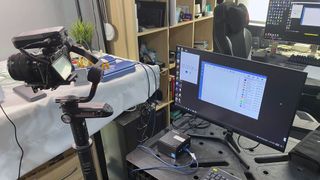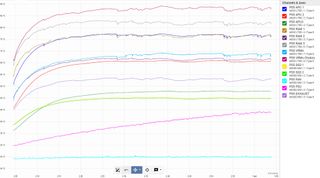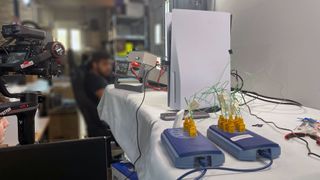I Changed the PS5's Power Supply. Did It Get Better?
Replacing the PS5's PSU with a power adapter.
Test Conditions
The ambient temperature in the lab was kept at 25 degrees Celsius during testing, and we used two Picoscope TC-08 temperature loggers to monitor the temperatures in the following places:
- APU Low (on the PCB, backside of the APU)
- APU Mid (between the back APU bracket and the mainboard’s metallic plate)
- APU high (on top of the mainboard metallic plate)
- Three different RAM modules
- Two flash memory modules
- VRM FET
- VRM Choke
- Fan inlet
- PS5 exhaust
- CWT Power Adapter (in the middle, top side)

Test Results


The photos above show in detail the parts and the corresponding temperatures.

Here's the complete graph of all sensors during the one hour of gaming, with CWT's power adapter installed in the PS5.


The charts help you see, easier, the differences between the original PSU and the CWT power adapter. To our surprise, not only did the temperatures not drop, but they were notably higher, especially in the APU. One of the RAM modules was also hotter, and the same goes for both flash memory modules that we measured. Finally, the difference in the VRMs is slight, but still, the CWT power adapter scenario performs worse.
Does it worth it? To replace the PS5's PSU?
It is clear that by removing the PS5’s PSU, we altered the internal airflow. Hence the operating temperatures got worse. On the other hand, the CWT power adapter outputs a higher voltage level than the ADP-400DR (12.335V vs. 12.078V), which can play a huge role.
Unfortunately, we don’t have the option to adjust the adapter’s voltage and lower it. Finally, we cannot know if the new adapter affected the APU’s frequencies, offering better performance. There is no benchmark for the PS5 available, and this would help find any performance differences between the original PS5 PSU and the power adapter that we tried.

Even though the operating temperatures increased, this is not worrisome since the PS5’s fan is working at very low speeds. An external power adapter has many advantages. The most important is that you can easily replace it if it fails without breaking apart the system.
Stay on the Cutting Edge
Join the experts who read Tom's Hardware for the inside track on enthusiast PC tech news — and have for over 25 years. We'll send breaking news and in-depth reviews of CPUs, GPUs, AI, maker hardware and more straight to your inbox.
Moreover, currently, the PS5’s PSU is maxed out at 200-210W DC load. We cannot know if Sony will increase the APU's speeds with future firmware upgrades, affecting power consumption. The thermal load will be raised at higher loads so that the power adapter might have an advantage there. If and when this happens, we will be here to conduct the exact thermal measurements, again, to find out the winner. Till then, we hope to see this CWT power adapter in the market since it will provide an alternative option to users that have a failed PS5 PSU and are out of warranty.
Aris Mpitziopoulos is a Contributing Editor at Tom's Hardware US, covering PSUs.
-
AnimeMania I guess you could disconnect the original PSU and leave it in place to maintain the airflow channels or insert a fan in the space where the PSU was to get better airflow.Reply -
Co BIY ReplyAnimeMania said:I guess you could disconnect the original PSU and leave it in place to maintain the airflow channels ...
I agree and think this would be a worthy experiment.
My expectation is that you would then get the improvements you were hoping for and good data for future repairs.
P5 content is probably gold so I expect Tom's can make this happen. -
Aris_Mp I cannot do this, unfortunately, because there will be no room for to connect the external PSU. The original PSU would cover the spade terminals of the mainboard.Reply -
RodroX ReplyAris_Mp said:I cannot do this, unfortunately, because there will be no room for to connect the external PSU. The original PSU would cover the spade terminals of the mainboard.
Nice article, now if you don't mind wasting a ps5 original psu, then that should be fixed with a dremel :) -
Kristjan G ReplyAris_Mp said:I cannot do this, unfortunately, because there will be no room for to connect the external PSU. The original PSU would cover the spade terminals of the mainboard.
Make a mock PSU casing or try to cover any holes that the original was blocking. As you might suspect, the airflow has changed. -
dwn2brasstacks Gut the old power supply, keep just the housing. Make neccessary changes so you can fit it back in, test. Add a small fan to exaust out of the back. Test. we are getting recycled hot air, let's use a cheap, efficient fan to correct it. We used to have to do this with branded computers back in the day to enhance the cooling.Reply
In fact, you could also use an existing stock system, add a small fan with vent holes or just augment the existing system. This would be hugely cheaper and more practical.
Try to find the hottest spot where you can vent air directly outside. -
artk2219 As others have stated that old PSU or something in its shape needs to stay in its place. It could make for a nice kit though, PSU and place holder in one kit so you dont have to modify the old PSU at all.Reply -
guyWhoBreaksThings I'm trying to build a simple PS5 by just buying the motherboard, then finding cheaper components and liquid cooling the motherboard.Reply
What exactly is the process of attaching an external power supply? Do I solder a female adaptor to the spade connectors? If so, which one goes where? I have no idea what to do for the PSU side of things, so any help would be appreciated.
Most Popular






